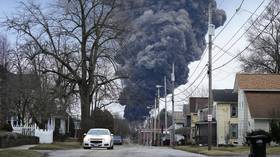Ohio train derailment ‘100% preventable’ – regulator

The devastating chemical spill caused by the derailment of a Norfolk Southern train in East Palestine, Ohio earlier this month was “100% preventable,” National Transportation Safety Board (NTSB) chair Jennifer Homendy told reporters on Thursday. The press conference followed the agency’s release of a preliminary report on the incident.
“We call things accidents. There is no accident,” Homendy said. “Every single event we investigate is preventable.” However, she added, there was no indication that the train crew had done anything wrong.
“Know that the NTSB has one goal, and that is safety, and ensuring this never happens again.”
The NTSB’s preliminary report on the disaster revealed that the temperature of one of the train’s wheel bearings spiked 215 degrees Fahrenheit over the last 30 miles (48km) it traveled, confirmed by two sensors placed along the route used to detect hot bearings.
While Norfolk Southern confirmed on Thursday that the heat sensors were working properly, the train’s own alarm was not set to go off until an even higher temperature was reached. By the time the alert sounded, the bearing was 253 degrees hotter than its surroundings, and while the engineer quickly acted to slow the train, the bearing reportedly failed, causing a derailment at the 23rd car, according to the report.
The plastic pellets inside the car caught fire when they were exposed to the overheated bearings, soon spreading to the 11 other cars containing hazardous materials, including five full of vinyl chloride that authorities ultimately decided to vent and burn onsite. The investigation determined this action was taken because the temperature inside one of the tanks full of vinyl chloride was continuing to rise, leading the operator to fear an explosion was imminent.
Acknowledging that it was “too early to tell” for certain how the disaster could have been avoided, Homendy told reporters that the NTSB will continue to investigate whether industry safety standards regarding the heat threshold for high-temperature alarms and other defect detectors, rail car and wheel design, and the spacing of sensors along the track need tweaking.
Norfolk Southern’s inspection practices will also be scrutinized, and the agency will look at whether the rail operator properly disposed of the vinyl chloride, she said. Residents have blamed the fire for a growing number of bird, livestock and fish deaths as well as water contamination in the area, although state and federal officials insist the air and water are safe.













